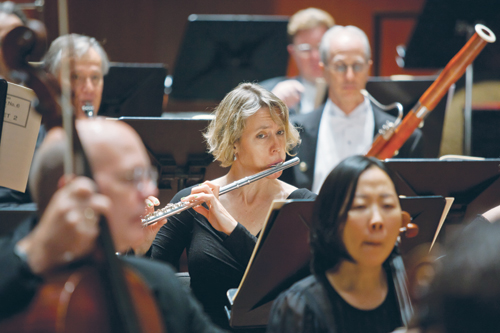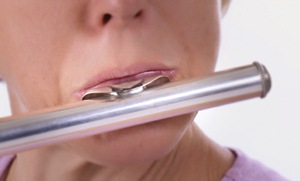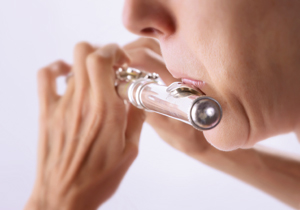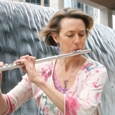
Aralee Dorough is principal flutist of the Houston Symphony, an affiliate artist at the Moores School of Music at the University of Houston, flute professor at the Texas Music Festival, and an active performing and recording artist. Besides her work in the classical music field, she regularly collaborates with her father, jazz artist and Schoolhouse Rock composer, Bob Dorough. She is a graduate of the Oberlin Conservatory (Robert Willoughby) and continued her studies at the Yale School of Music (Thomas Nyfenger).
What was it like growing up with a jazz legend for a father?
Even math was fun at our house. My dad started composing “Multiplication Rock” (the first of the animated TV series Schoolhouse Rock) when I was nine. It is my voice saying, “Zero?” on the song “My Hero, Zero,” which also has beautiful flute solos that were played by Hubert Laws. Later, when I was in college, I got to play flute and piccolo on some of the later songs of the series. I have always loved going into the recording studio in New York City and watching my dad work. I also love watching him perform for an audience. He has incredible warmth and charisma on stage.
My mother was also a creative, fun person. We lived in the country in Pennsylvania with a big organic garden, pets, and farm animals, and she did it all. She was a dancer and had a dancer’s discipline; she never missed a day of limbering up, as she called it. She studied acrobatics in Germany and when she came to the U.S. she performed in New York City, Las Vegas, the Catskills, and the Poconos, where she met my father during a summer’s engagement at Mt. Airy Lodge. Her dance routine was something similar to a Cirque de Soleil performance: feats of limberness artistically set to music with imaginative costumes that she made herself.
My father always had us making music in various ways as a family, but I did not practice the flute much. I did many things more seriously: art, gymnastics, judo and track. As a last ditch effort to test out whether I could be serious about music, my father surprised me with the gift of a new flute and offered to get me a private teacher in New York. I began taking weekly lessons with Nadine Asin and, inspired by her beautiful sound, I began practicing every day. My mother would take me out of school several hours early and we would make the two-hour drive to Manhattan. I would get out of the car in front of Nadine’s building for my lesson, and afterwards ride the bus down Broadway to the studio of renowned tap teacher Henry LeTang where my mom was having a lesson. I even took some tap lessons myself for a period of time, but soon I began to focus more on flute.
Why did you choose to attend Oberlin and then Yale?
It was most definitely for the teachers. After dabbling in so many things growing up I wanted to attend a conservatory and work at music full time. I was accepted to Yale as an undergraduate and was very tempted, but knew I would be distracted by other subjects. I had a lesson with Thomas Nyfenger at the time, and he encouraged me to go to Oberlin and study with Willoughby instead. Therefore, I was very pleased to be able to go to Yale School of Music for graduate school. Nyfenger was very instrumental in getting me ready for my audition for the Houston Symphony.
What were the challenges of auditioning for the Houston Symphony while still finishing graduate school?
It was my first major audition, for the position of second flute. I did not have any expectation of winning it, and yet, at the same time I had a certain serious intent about it, an idea that I could win it. Without that element, I would not have been able do what I did to prepare. I had taken two auditions for very small regional orchestras the year before, so I had some experience of the intensive practice required. Once my tape for Houston was accepted, I dropped everything in my life for three weeks to cram full time. I cut classes and weaseled out of rehearsals. There were many inconveniences. One of my roommates wouldn’t let me turn up the thermostat, so I bought an electric radiator and turned my drafty room into a tropical paradise so that I could practice the opening of Daphnis without my tendonitis flaring up. The extra power the heater needed would trip the circuit breaker. Then I had to stop practicing and run down four flights of stairs to the basement to flip it back. One week before the audition I bent a key on my flute.
Did you have to audition for the principal flutist position with the Houston Symphony since you were already playing second chair?
Yes, and I lost the audition, but then an enormous opportunity dropped into my lap. I was asked to sub as acting principal for a whole season while the search for principal continued. I did not get the opportunity to play many principal parts during my conservatory years, and with this experience I discovered I could do it and also loved it. I put everything I had into each concert. It was during this time that I began completely changing my breathing technique with the help of Keith Underwood in New York. By the time the season, and my contract, ended, I had gone from substitute to contender to winner.
What is a typical week’s schedule with the Houston Symphony?
Today is Monday, and that is usually my day off. Yesterday we did a Mozart Concert. The next few days we will rehearse a program of Strauss, Adams, and Holst and do three performances. Then next Monday we will spend four hours recording Also Sprach Zarathustra for a DVD that will be called Orbit. The following week we do Pops shows in the evenings and children’s shows in the mornings. I like that it is different every week, but the schedule does make it hard to plan other activities.
How does teaching at the University of Houston fit into the week?
It is tricky, so I usually limit my studio size to about four to six students. My students are wonderfully patient when we have to shift lesson times. The benefit to them of my being a full-time symphonic player is that whatever I am playing that week can become part of what we are studying. I have been teaching for five years as one of four adjunct flute teachers who are also professional performers. The school’s location in the heart of a big city surrounded by performing arts means that there is a great concert nearly every night of the week.
What are your ideas about developing a wide palette of colors?
If thinking in terms of color does not work for you, try tactile words like gritty, grainy, airy, fuzzy, compact, thick or thin. A big part of developing variety is listening and imitating. Tom Nyfenger could imitate any flutist or instrument. He would play the melody from the Mozart clarinet concerto and it sounded like a clarinet.
In technical terms, the important part of changing colors is the changing. Explore all the ways you can change pitch, dynamics and sound quality, by changing the way you are blowing, the aim of the air, rolling in and out, and changing what you are doing with your embouchure. You have to make some distorted sounds. Experiment in practice by playing too sharp, too flat, and too loud. I am a big fan of practicing pitch bending and multiphonics.
How do you teach embouchure?
I play with my corners down, but not too much. It is more important to think about where the airstream is going. There is more going on than meets the eye. Think about where the airstream hits the flute. Flutists should deliver air at a sufficient speed at a particular angle from a particular distance. When they get the combo just right, it feels and sounds great. The rest of the time, it is hard work. I visualize a flat airstream. Flat like a blade of grass, or an oboe reed – my husband plays the oboe.
Where is the tongue placed?
The tongue is this enormous thing lurking in our mouth. Flutists forget about it except when they want to articulate. Aware of it or not, it shapes the sound, because it shapes the airstream. If you want a fast, flat airstream, the tongue can help. I keep my tongue forward and wide in my mouth to help pre-shape the air. I have my corners down and outward, and my tongue widens to meet them. Don’t pucker your lips around an invisible drinking straw; smash the straw flat.
I have begun to think a lot about the space that is created by the front half of the tongue, the front teeth, the gums behind the teeth, and the hard palate. This space is important because it can be subtly varied to help manage the airstream before it gets to the lips. I have started to think of this as the pre-embouchure.
Articulation problems arise when that pre-embouchure changes during attempts to single or double tongue. The space becomes larger, the airspeed slows and tone suffers. I attempt to make the “t” or “d” syllable with the middle of my tongue on the hard palate, while keeping my tongue in the very forward wide position described above.
I often use a sort of “p” attack on first notes, but it is with the inside of my top lip on the top of my tongue, while my tongue is anchored on my lower teeth and lower lip, rather than an actual lips together “p.”
What are your thoughts about breathing?
Many popular notions about breathing are wrong. I feel so fortunate that I was introduced to the principles of Arnold Jacobs, tuba player of the Chicago Symphony, via flutist Keith Underwood. Jacobs had many brass students come to him for help with what they thought were embouchure problems, but he would help them by changing their concepts about air use using specific language, imagery and devices for measuring air. One such device was a five-liter latex bag he would have the player breathe into and then rebreathe the same air. When Underwood, who I consider one of my biggest mentors, first had me play my flute with air I had breathed in from the bag, I knew in an instant that this was going to transform my playing. I knew from the way it sounded and from the way it felt.
What I had experienced at that moment was the feeling of playing the flute with air that was at low pressure until just beyond the embouchure, a result of coordinated breathing muscles instead of consciously trying to expand down low. One could call this natural, relaxed breathing, except that it is so hard to do. Keith taught me that Jacobs never used the words inhale, exhale, expand or support, because of their effortful, skeletal connotations. In their place, he talked about blowing and sucking the air, and would say, “play with the air from your mouth.” What is great about using the breathing bag is that for the first time you can actually see that very important component: your air. There are so many useful exercises you can do with the bag, but it really helps to have some coaching on how to do it.
Something simple anyone can try to stop over expanding is to match every breath to the phrase. Take a little less air than you think you need. It is a common habit to tank up at every opportunity, but often the ribcage stays expanded too long, and we lose the feeling of useable air at the mouth. The first phrase of a piece is often one of the shorter ones, with a long one coming, so sometimes in lessons I will help students by calling out, “small, small, medium, big!”
What are your thoughts about vibrato?
I love vibrato and enjoy helping my students with it. Often students have some technical problems that need to be solved first. An exercise called vibrato on vibrato off is a good litmus test. It calls for a big, fast vibrato with a specific way of starting and stopping, and it is difficult to do unless one plays with feeling of air from the mouth, as discussed above. If air is over pressurized in the body, it is difficult to make the small, quick fluctuations that create vibrato.
When talking about musical applications, I try to be very specific, and not just say, more vibrato. I might ask for more vibrato on a particular note instead. I think flutists should put thought into when and how to use vibrato, and I will often plan out where I want each wave to fall.
How do you work on stance and aligning and balancing the flute?
One of the best ways to improve all around performance is to address the biomechanics of playing. Something I find really fascinating is that each time I make a mechanical adjustment, I hear a corresponding change in my sound. A little more resonance, a little more ease in the vibrato. Flutists tend to compartmentalize sound as being a function of the embouchure, but everything is connected. You can flip it around to your advantage and use your sound as feedback when trying out a better way to hold the flute or a better way to stand. Test out stance A versus stance B by listening for change. If B sounds better, it is better.
What makes biomechanical efficiency so elusive is that nothing can ever be static. As soon as you have found the right posture it is no longer right for the next moment, and you have become locked, or fixed, as they say in the Alexander Technique. I am convinced that the most comfortable way to play is to be aware of the subtle changes required by each phrase. Subtle is a key word here. Big motions, swaying, shoving the neck or shoulder forward for emphasis, any movements done as habit, obscure that awareness. The first step is to learn to play without moving which is very difficult. Be still so you can be fluid. Once you have found control you can carefully add some joyful motion back into the performance.
What is your practice routine?
I think a lot about how to practice as practicing is an art. You are what you practice. For me it is about getting orchestra parts in reliable condition with as little wear and tear on my body and in as little time as possible. That means practicing very cleverly. When I am in shape, I do not really need to warm up. I focus more on warming up my arms and getting the right grip on the flute so that I avoid tension. To get in shape, there is nothing better than patterns such as scales or arpeggios. Lately I have been experimenting with the way I work the different registers when I play patterns. To boost tone and endurance in a given register, select patterns that stay within a narrow range. Doing lots of articulation work really benefits overall sound. It is also important to mix in different dynamics.
What are your thoughts on developing projection?
Nyfenger was adamant that there was certain grit in the sound that was essential. Basically, he wanted more overtones. He was warning us against being so concerned with focus up close that we would lose those overtones and sound thin, especially in a concert hall. The hall I play in is very large and not particularly resonant. I try to make a rich sound while pretending to resonate an imaginary bubble of space at arm’s length around me. Otherwise I start to push too hard. In unfamiliar halls this visualization keeps me from getting distracted by what the hall is telling me.
Can phrasing be taught?
Absolutely. There are ways to give musical notes extra meaning just as there are ways to give spoken words meaning. As with vibrato, there are some technical skills to acquire first before you can explore phrasing. However, once you have worked hard to be able to play with a homogenous sound at one consistent dynamic, for example, you get to break those rules. Play some notes mutedly and really dig into others.
Bob Willoughby taught us how to draw conclusions about what the music might want to say. We would look at the meter and the harmonic structure and ask, is there repetition? What material is new? What note seems most interesting? Once we had developed an opinion on it he would patiently insist we make our choices crystal clear, using any combination of strategies: dynamics, colors, agogic accents, and, something I find students have often overlooked, rubato. Learning how to use rubato subtly to enliven a phrase is extremely useful.
Ideally it is the desire to play expressively, to say something, to express one’s feelings about the music, that should drive technique.
How did your new CD Colours come about?
I have always loved recording and dreamed of doing my own albums, but it took me this long to commit to spending money on my own project. I love recording with the Houston Symphony and have been lucky to get to record the Mozart Concerto and chamber works (The Schoenberg Woodwind Quintet), but I wanted to have a flute CD of my own.
I decided to make Colours so that people outside of Houston could get to know my playing. I play concerts week after week with the Houston Symphony and have been doing it for years in relative obscurity as far as the rest of the world goes. When I had the idea to arrange Stravinsky’s Pulcinella Suite and Bartók’s Roumanian Dances for flute and piano, I realized that in combination with two other pieces I love to play in recitals, Platonov’s arrangement of Afternoon of a Faun and the Barber Canzone, I had the makings of a recording project that suited my strengths as an orchestral player.
Doing my own project gave me control over the sound of the finished product. I wanted to record in a concert hall, and I was fortunate enough to be able to use the Moore Opera House with its excellent acoustics.
After the recording and editing were finished I started working on the design and other details. I set out to produce as professional a product as possible since I am not using a record label. I have enjoyed selling the CDs directly from my website, because I can thank each person who buys one for their support and encouragement.
My next CD will include chamber music by Mozart and Beethoven. It will be called The Ergonomic Flute because I will be playing the flute vertically, using a special headjoint.
Embouchure

In this front view of a low E the lips and tongue are drawn wide, making a flat and compact airstream. The top lip is not reaching forward, as in a pucker, and yet it is forward of the bottom lip, as revealed in the next photo.

In this profile view, the upper lip, positioned forward of the lower lip, is directing air straight down into, rather than across, the blow hole, producing a low E. Inside the mouth, the tongue’s forward and high position assists in directing a fast, but very small, airstream from high up in the mouth, straight downward. These points are all key in producing a satisfying low note.
Notice that a considerable amount of the blow hole is covered by the lower lip, and the lip plate is low on the chin. The left hand is playing a part as well. While there is little pressure towards the face, there is torque upward and outward which helps to arrange the lip across the plate. It is the profile view of embouchure that flutists should visualize in seeking the optimal set up for each register.
Photos by Daryl Kessler






